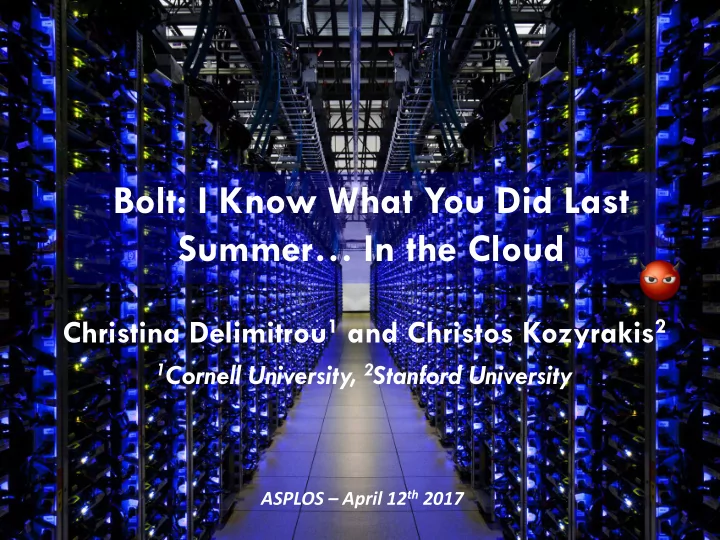

Bolt: I Know What You Did Last Summer… In the Cloud Christina Delimitrou 1 and Christos Kozyrakis 2 1 Cornell University, 2 Stanford University ASPLOS – April 12 th 2017
Executive Summary Problem: cloud resource sharing hides security vulnerabilities Interference from co-scheduled apps leaks app characteristics Enables severe performance attacks Bolt: adversarial runtime in public clouds Transparent app detection (5-10sec) Leverages practical machine learning techniques DoS 140x increase in latency User study: 88% correctly identified applications Resource partitioning is helpful but insufficient 2
Motivation App1 App2 3
Motivation App1 App2 containers 4
Motivation App1 App2 containers memory capacity 5
Motivation App1 App2 containers memory capacity storage capacity/bw 6
Motivation App1 App2 containers memory capacity storage network bw capacity/bw 7
Motivation App1 App2 LL cache containers memory capacity storage network bw capacity/bw 8
Motivation power App1 App2 LL cache containers memory capacity storage network bw capacity/bw 9
Motivation power Not all isolation techniques available App1 App2 LL cache Not all used/configured correctly containers Not all scale well Mem bw/core resources not isolated memory capacity storage network bw capacity/bw 10
Bolt Key idea: Leverage lack of isolation in public clouds to infer application characteristics Programming framework, algorithm, load characteristics Exploit: enable practical, effective, and hard-to-detect performance attacks DoS, RFA, VM pinpointing Use app characteristics (sensitive resource) against it Avoid CPU saturation hard to detect 11
Threat Model Cloud Adversary Victim provider Impartial, neutral cloud provider Active adversary but no control over VM placement 12
Bolt App Contention 1 3 inference injection Adversary Victim 2 Interference Impact measurement 13
Bolt App Contention 1 3 inference injection Custom 4 contention Adversary Victim kernel Performance attack 5 2 Interference Impact measurement 14
1. Contention Measurement Set of contentious kernels (iBench) 1 Contention injection Compute L1/L2/L3 Adversary Victim Memory bw 2 Interference Storage bw impact Network bw measurement (Memory/Storage capacity) Sample 2-3 kernels, run in adversarial VM Measure impact on performance of kernels vs. isolation 15
2. Practical App Inference Practical app inference Infer resource pressure in non- 3 profiled resources Sparse dense information Adversary Victim SGD (Collaborative filtering) Classify unknown victim based on previously-seen applications Label & determine resource sensitivity Content-based recommendation Hybrid recommender 16
Big Data to the Rescue Infer pressure in non-profiled resources 1. Reconstruct sparse information Stochastic Gradient Descent (SGD), O(mpk) Contention injection Bolt uBench uBench Data Interference App App App profile App SVD+SGD r 1 r 2 r 3 … r N r 1 r 2 r 3 … r N a 11 0 0 … a 1N a 11 a 12 a 13 … a 1N 0 a 22 0 … 0 a 21 a 22 a 23 … a 2N … … … … … … … … … … 17 a M1 0 a M3 … 0 a M1 a M2 a M3 … a MN
Big Data to the Rescue Classify and label victims 2. Weighted Pearson Correlation Coefficients Output: distribution of similarity scores to app classes Bolt Data App label & App App characteristics App App Pearson Corr Coeff r 1 r 2 r 3 … r N Hadoop SVM: 65% a 11 a 12 a 13 … a 1N Spark ALS: 21% a 21 a 22 a 23 … a 2N memcached: 11% … … … … … … a M1 a M2 a M3 … a MN 18
Inference Accuracy 40 machine cluster (420 cores) Training apps: 120 jobs (analytics, databases, webservers, in- memory caching, scientific, js) high coverage of resource space Testing apps: 108 latency-critical webapps, analytics No overlap in algorithms/datasets between training and testing sets Application class Detection accuracy (%) In-memory caching (memcached) 80% Persistent databases (Cassandra, MongoDB) 89% Hadoop jobs 92% Spark jobs 86% Webservers 91% Aggregate 89% 19
3. Practical Performance Attacks Custom kernel 4 Determine the resource injection 1. bottleneck of the victim Create custom contentious 2. Adversary Victim kernel that targets critical resource(s) Inject kernel in Bolt 3. Several performance attacks (DoS, RFAs, VM pinpointing) Target specific, critical resource low CPU pressure 20
3. Practical DoS Attacks Launched against same 108 applications as before On average 2.2x higher execution time and up to 9.8x For interactive services, on average 42x increase in tail latency and up to 140x Bolt does not saturate CPU Naïve attacker gets migrated 21
Demo 22
User Study 20 independent users from Stanford and Cornell Cluster 200 EC2 servers, c3.8xlarge (32vCPUs, 60GB memory) Rules: 4vCPUs per machine for Bolt All users have equal priority Users use thread pinning Users can select specific instances Training set: 120 apps incl. analytics, webapps, scientific, etc. 23
Accuracy of App Labeling 53 app classes (analytics, webapps, FS/OS, HLS/sim, other…) 24
Accuracy of App Characterization Performance attack results in the paper 25
The Value of Isolation 45% 14% Need more scalable, fine-grain, and complete isolation techniques 26
Conclusions Bolt: highlight the security vulnerabilities from lack of isolation Fast detection using online data mining techniques Practical, hard-to-detect performance attacks Current isolation helpful but insufficient In the paper: Sensitivity to Bolt parameters Sensitivity to applications and platform parameters User study details More performance attacks (resource freeing, VM pinpointing) 27
Questions? Bolt: highlight the security vulnerabilities from lack of isolation Fast detection using online data mining techniques Practical, hard-to-detect performance attacks Current isolation helpful but insufficient In the paper: Sensitivity to Bolt parameters Sensitivity to applications and platform parameters User study details More performance attacks (resource freeing, VM pinpointing) 28
Evolving Applications Cloud applications change behavior Users use the same cloud resources for several apps over time Bolt periodically wakes up, checks if app profile has changed; if so, reprofile & reclassify 29
Inference Within a Framework Within a framework, dataset and choice of algorithm affect resource requirements Bolt matches a new unknown application to apps in a framework by distinguishing their resource needs 30
Recommend
More recommend